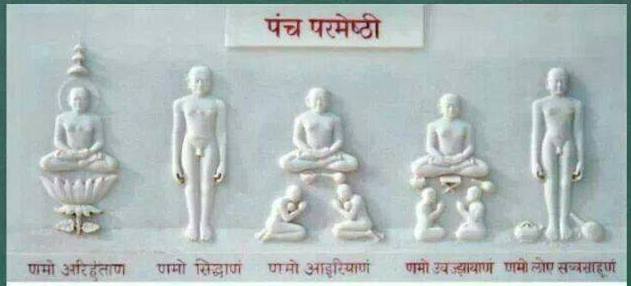Basic teachings of Jainism
Jainism
Everything
starts with Namokar mantra, so,
Namo Arihantanam
Meaning: Salutation to Arihanta
Namo Siddhanam
Meaning: Salutation to Siddha
Namo Ayiriyanam
Meaning: Salutation to Acharya
Namo Uvajjhayanam
Meaning: Salutation to Upadhyaya
Namo Loye Savv Sahunam
Meaning: Salutation to the Saints of the whole world
Jainism is a religion of non violence.
It is believed in Jainism that not only human but each and every
living organism, ranging from Giant blue whale to small micro-organisms that
can’t be seen with naked eyes must not be harmed, since every living thing has
a soul and in the course of re-incarnation, every soul has the capacity of enlightenment.
Jains do not believe in a creator god but Tirthanker (Enlightened
ones). There are 24 Tirthankeras in Jain religion namely:
1. Adinath Ji
2. Ajitnath Ji
3. Sambhavnath Ji
4. Abhinandannath Ji
5. Sumatinath Ji
6. Padmprabhu Ji
7. Suparshvnath Ji
8. Chandaprabhu Ji
9. Pushpdantnath Ji
10. Sheetalnath Ji
11. Shreyansnath Ji
12. Vasupoojya Ji
13. Vimalnath Ji
14. Anantnath Ji
15. Dharmnath Ji
16. Shantinath Ji
17. Kunthunath Ji
18. Arahnath Ji
19. Mallinath Ji
20. Munisuvratnath Ji
21. Naminath Ji
22. Neminath Ji
23. Parshvnath Ji
24. Mahaveer Ji
Jain literature is very vast, so I would only explain Jain teachings,
which are more important to know.
The Karmic account of every soul decides what another living thing
that soul will re-incarnate into. Many living things, like lion don’t have the
choice to be non-violent, since it is their nature to kill, but we humans are
the lucky ones since we have the choice to think before acting to any given
situation. Though we have got this human life as a result of good Karma, still
every human faces different situations in the lifetime, because of the
difference in the karmic accounts. It is truth that there is violence in
nature, but we can decide to be non violent. Jainism prohibits all kinds of
violence in all forms, and there is no justification for harming any living
thing, knowingly or unknowingly.
To understand this better, consider a dog barking at you at a street.
You get scared and kick the dog. Now, Dog is a dog for its past accounts and it
is a dogs nature to bark when someone new crosses his street. You got trapped
in the situation because of some bad karma in your past life. Dog became the
medium for you to pay for that bad karma.
Where you could have easily avoided the dog by slipping from side,
you kicked him. Now the Dog got kicked for his bad karma, you acted violently
and became the medium.
The most basic principles of Jainism are Ahimsa (Non-Violence), Aparigrah (Non-
Attachment) and Anekantwaad (Different point of views are correct and incorrect
at the same time). Anyone who understands these three principles can
easily theorize the rest of the rules in Jainism, since everything is based on
these three pillars only.
Ahimsa:
Ahimsa is of
three types, ahimsa from thoughts, speech and Karma.
Ahimsa from
thoughts:
If you curse someone or you
want something bad for someone, then these thoughts are violent thoughts, i.e.
a form of violence. Understanding, that anything bad that has happened to us is
the result of our own karma and the bad doer is definitely going to pay, helps
us to think before we think curse words in our minds and saves us from the bad
karma of violent thoughts.
If you think something
bad, it is Violence
Ahimsa from
Speech:
Hurting someone by saying bad words is also a form of violence and we
should never do that.
If you scold
or abuse someone, it is Violence
Ahimsa from
karma:
We should never harm any living thing by our karma. Not only killing,
but even hurting any human, animal or microorganism is prohibited in Jainism.
Aparigrah:
Aparigrah means Non-Attachment. There is a difference between love
and attachment. Loving something or someone is a good thing, since you are not
bound to anything you love. You don’t have any liability or ownership for
something you love, rather you just let the things or the person, be the way
they are. If the reason behind loving something or someone is because you own
them, or at least you think that you own them, then it is attachment. Being attached
isn’t a very bad thing since you do not hate or do anything bad or violent,
rather you actually love, but still the love here, has a condition that you
want to be rewarded with the same kind of love in return.
We humans are attached to our community, neighbors, family, friends,
our home, car, etc. Aparigrah teaches that everything you have i.e. house, car,
youthfulness, beauty, money, strength or anything you own is not permanent, and
no matter how badly you want those to retain forever, you are going to lose
these luxuries when the time comes. Anything you have is because of the good
karma in past life and you neither own nor control the time when these things
go away. So,
there is nothing in life for which should be collected or we should do violence
for, or be envy or proud of. We should not be attached to anything or anyone,
but love them, since we do not control when those things or people will be long
gone.
Anekantwaad:
Anekantwaad is the study of the complete nature of the object. Though
we humans consider ourselves the most intelligent ones, still we have some
limitations. We are not able to understand the complete nature of the ‘object’
because of limited perspective. We see or feel whatever we are comfortable with
from our point of view. The object referred above, means any material thing, a
view, a sound or a situation, anything. For example, consider a scholar who can read
and write in the language of seven different countries. For the rest of the
world where those seven languages are not used, that same scholar is an
illiterate person. This is the difference between the perspective of the people
of those seven countries and the rest of the world, and both are correct at the
same time.
In our day today life, we can have a situation where, you are
attached to everything around you, just like most people are. There is some
situation where your neighbor doesn’t agree with you. From your point of view,
you are absolutely right and it is very easy for you to think “I have been
attached to that neighbor for so long, why doesn’t he understand the situation
and act accordingly. Either he is a fool or doing so deliberately to hurt me.
Okay, I will teach him a lesson, when I get a chance.” There is nothing wrong
in having such thoughts, since your neighbor is also having the same kind of
thoughts. If both the parties had the capability to understand the other point of
view, or had accepted that, though they can’t understand, still there can be a
different point of view, two good people would have not turned bad.
According to Jain philosophy, understanding the complete nature of
the object (vastu ka swaroop) is called Kewal gyan. Knowledge about anything and
everything is the main goal of life in Jain culture, but only a few i.e.
enlightened ones are able to attain the state of kewal gyan.
It is very
easy to follow Jainism, just practice all forms of non-violence, aparigrah and
try to attain kewal gyan.
Just like other religions, Jains also have their temples and a very
rich literature. Unlike other religions, our gods does not do anything. They do
not grant wealth or power, but knowledge and wisdom. In Jain teachings, if someone
attains something in life, then it is not the work of god, but the persons own
karma. God only gives wisdom, man chooses weather to follow his wisdom or not.
If he succeeds, then it is because of his own good karma, it is that simple.






.jpg)
Comments
Post a Comment